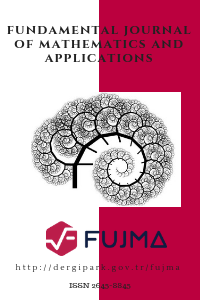Approximate Fuzzy Inverse Matrix Calculation Method using Scenario-based Inverses and Bisection
Approximate Fuzzy Inverse Matrix Calculation Method using Scenario-based Inverses and Bisection
Approximate fuzzy inverse, Bisection method, Fully fuzzy linear system of equations, Fuzzy matrix Fuzzy numerical simulation,
___
- [1] S. Chanas, M. Nowakowski, Single value simulation of fuzzy variable, Fuzzy Sets Syst., 25(1) (1988), 43-57.
- [2] J. Rohn, Inverse interval matrix, SIAM J. Numer. Anal., 30(3) (1993), 864-870.
- [3] S. S. Rao, L. Chen, Numerical solution of fuzzy linear equations in engineering analysis, Int. J. Numer. Methods Eng., 42(5) (1998), 829-846.
- [4] M. Dehghan, M. Ghatee, B. Hashemi, Inverse of a fuzzy matrix of fuzzy numbers, Int. J. Comput. Math., 86(8) (2009), 1433-1452.
- [5] M. A. Basaran, Calculating fuzzy inverse matrix using fuzzy linear equation system, Appl. Soft Comput., 12(6) (2012), 1810-1813.
- [6] M. Mosleh, Evaluation of fully fuzzy matrix equations by fuzzy neural network, Appl. Math. Modell., 37(9) (2013), 6364-6376.
- [7] M. Mosleh, M. Otadi, A discussion on “Calculating fuzzy inverse matrix using fuzzy linear equation system”, Appl. Soft Comput., 28 (2015), 511-513.
- [8] J. Kaur, A. Kumar, Commentary on “Calculating fuzzy inverse matrix using fuzzy linear equation system”, Appl. Soft Comput., 58 (2017), 324-327.
- [9] X. Guo, Y. Wei, Z. Li, Further investigation to approximate fuzzy inverse, J. Intell. Fuzzy Syst., 35(1) (2018), 1161-1168.
- [10] C. Y. Chen, J. J. Huang, Deriving fuzzy weights of the fuzzy analytic network process via fuzzy inverse matrix, Mathematics, 7(10) (2019), 914.
- [11] F. Babakordi, N. A. Taghi-Nezhad, Calculating fuzzy inverse matrix using linear programming problem: An improved approach, Pak. J. Stat. Oper. Res. (2021), 983-996.
- [12] H. Farahani, M. J. Ebadi, Finding fuzzy inverse matrix using Wu’s method, J. Mahani Math. Res. Cent., 10(1) (2021), 37-52.
- [13] H. G. Akdemir, H. G. Kocken, A new fuzzy linear regression algorithm based on the simulation of fuzzy samples and an application on popularity prediction of Covid-19 related videos, J. Stat. Manage. Syst., 25(8) (2022), 2025-2041.
- [14] P. V. Saraev, Interval pseudo-inverse matrices and interval Greville algorithm, Reliab. Comput., 18 (2013), 147-156.
- [15] J. Lebedinska, On another view of an inverse of an interval matrix, Soft Comput., 14(10) (2010), 1043-1046.
- ISSN: 2645-8845
- Yayın Aralığı: Yılda 4 Sayı
- Başlangıç: 2018
- Yayıncı: Fuat USTA
An Examination for the Intersection of Two Ruled Surfaces
New Traveling Wave Solutions for the Sixth-order Boussinesq Equation
On Some Spectral Properties of Discrete Sturm-Liouville Problem
Ayşe Çiğdem YAR, Emrah YILMAZ, Tuba GULSEN
Approximate Fuzzy Inverse Matrix Calculation Method using Scenario-based Inverses and Bisection
The Form of Solutions and Periodic Nature for Some System of Difference Equations
